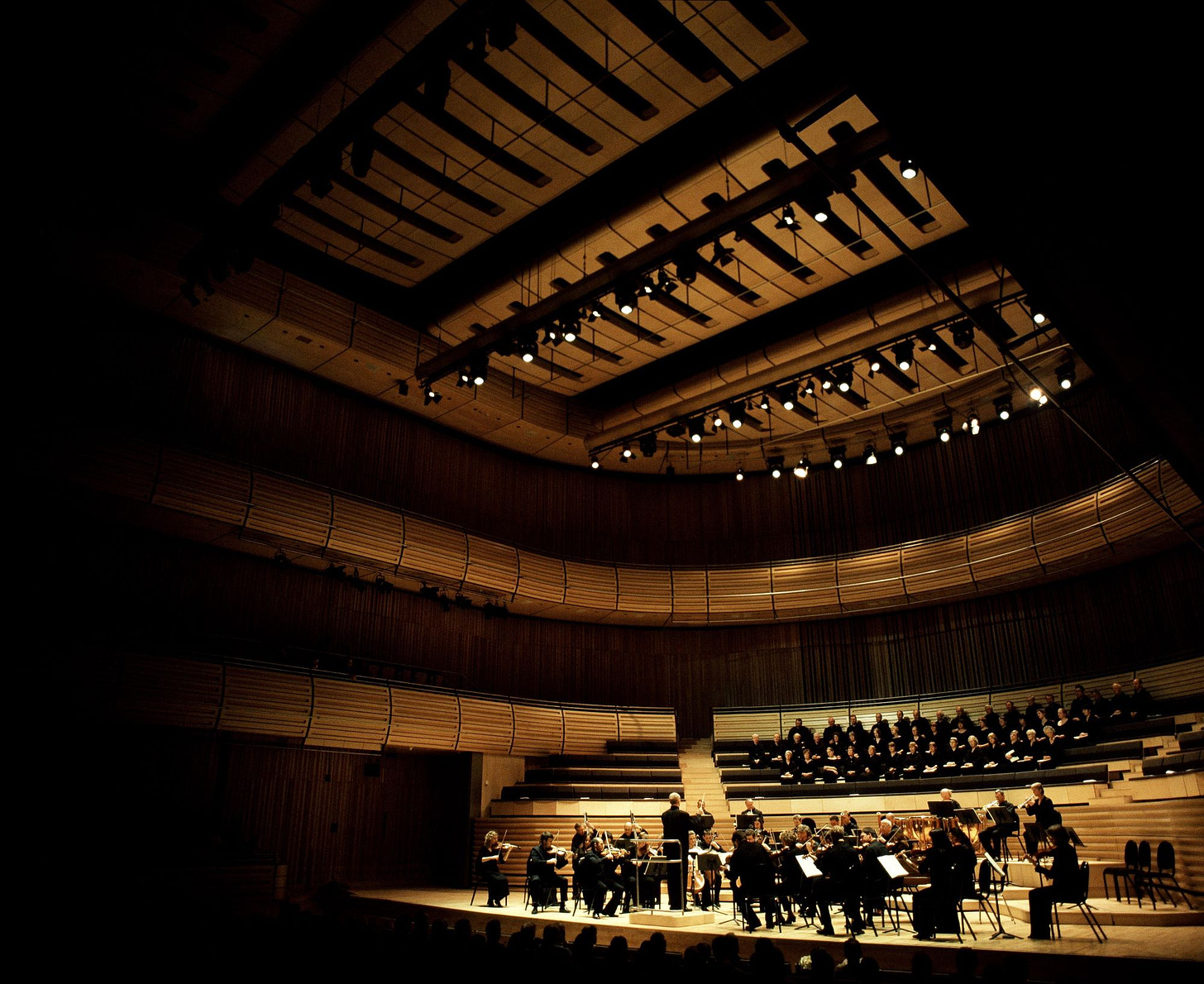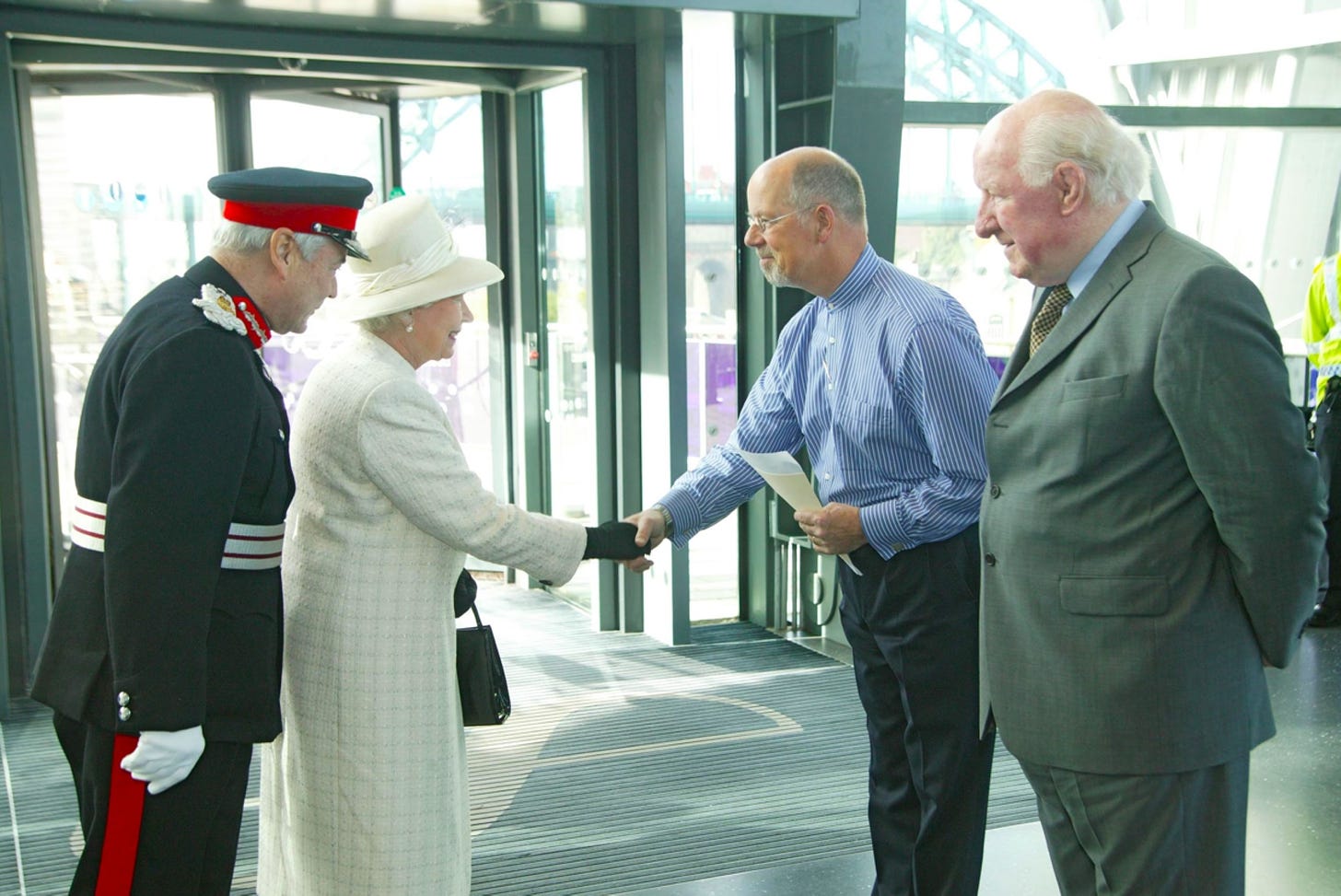Raising a Glass(house) to 20 years of music
Happy birthday to you! The Glasshouse, where the music happens, is 20. David Whetstone – and Ros Rigby, former performance programme director – remember the opening of the building in 2004.
Amazingly, quite shockingly, it’s 20 years since the building now called The Glasshouse International Centre for Music – The Glasshouse for short – first opened to the public.
Goodness! Where does the time go?
December 17, 2004, was when we first got to see beneath that silvery, undulating roof to experience the finished article, the first performing arts building designed by celebrity architects Foster and Partners.
That chill night was unforgettable. But who really felt the cold as we queued outside the west door next to a giant cartoon statue of Pavarotti, designed by Geoff Laws for Dodgy Clutch Theatre Company?
Once inside… well, a big crowd and breathless excitement. Then the disembodied voice of Ros Rigby, familiar from countless folk gigs in community centres and village halls, floated over our heads.
Her greeting, amplified and acoustically perfect, heralded a new era for music-making in the North East.
The Times had already called it “the most exciting music venue in Britain”.
It was to be the new home of the (subsequently Royal) Northern Sinfonia after many years at Newcastle City Hall where the orchestra’s pianissimo moments were liable to be interrupted by the sound of people splashing in the pool next door.
The orchestra was a founding partner in the new venture, as was Folkworks, co-founded by Ros and concertina player Alistair Anderson who must have performed there many times now.
Over that opening weekend there were taster performances in both concert halls, the big and the small, and in the multi-purpose space between them.
The music attracted people, of course. But so did the new views of the Tyne and Newcastle Quayside. The sweeping concourse was trodden by 15,000 people over those introductory few days.
When Private Eye’s architecture critic derided it as slug-like, most in this region dismissed his assessment as sour grapes. How dare Gateshead have something like that?
Gateshead very nearly didn’t get it.
The building had been destined originally for Newcastle but when the council couldn’t agree on a site, the Arts Council, fearing the loss of the lottery money already attached to the project, threw it open to tender.
There were five bids from within the region. Gateshead won and the post-industrial hotch-potch of Pottery Bank was duly transformed with the curvy roof echoing the arc of the Tyne Bridge and its upstart neighbour, the Gateshead Millennium Bridge.
Those with long memories will recall the building rising from the mud, first as an unimpressive arrangement of blocks but then, with the roof added like the silver dome over a posh restaurant’s main course, sensational (unless you were ‘Piloti’ of Private Eye, that is).
Many are the musical stars and prodigies who have performed there since. I remember waiting late in the newsroom one night for the verdict of one of the very earliest performers, opera singer Lesley Garrett. Fresh off stage, she said she loved it. Naturally.
The building has turned 20 but the story is older than that. A feasibility study in 1990 had highlighted the need for a major music facility in the region and the launch of the National Lottery in 1994, with oodles of money for good causes, made it possible.
Foster and Partners won the design competition in 1997 along with Arup Acoustics.
Anthony Sargent was appointed general director in November 1999, before site clearance even began, and the work that would eventually be focused on the 25-room education centre below the concourse started with outreach sessions across the region.
The aim, it was always made clear, was for the influence of the building now known as The Glasshouse to stretch far and wide. More than a venue, it was to be a catalyst for music across Gateshead and beyond.
Abigail Pogson, now holding the reins as Anthony Sargent’s successor, is operating in more financially straitened times, to say the least.
The cost of the building - £70m including £47m of lottery money – speaks volumes about the economic contrast between then and now.
The Glasshouse (Sage Gateshead as was) and the charity that runs it have weathered several storms – austerity, Covid and a recent rebrand – but it’s clear that as the building enters its third decade the ambition remains intact.
Plans have been announced for a new Music Academy with a £2m donation from the Foyle Foundation helping to fund programmes designed to reach even more young people and emerging artists across the region.
Three artistic partnerships have also been announced with The Unthanks, Corinne Bailey Rae and violinist Maria Włoszczowska set to work with The Glasshouse and Royal Northern Sinfonia over the next three years.

And there’s the goal of making The Glasshouse the most affordable music centre in Europe, starting with the Music Pass, giving free access to newborns and their families for 10 years, and a hoped for doubling of the number of educational bursaries available for young people.
More than 14 million minutes of live performance have taken place beneath that famous roof over the past 20 years (according to someone perhaps with too much time on their hands) and there have been 2.7 million music classes run under the auspices of the charity.
Nobody can say that shimmering ‘slug’ on the Tyne hasn’t slithered to wonderful effect. Long may it continue to shimmer and slither.
If you’re attending any of the many and varied performances at The Glasshouse during this festive season (details on the website), maybe raise a glass in its honour – or maybe an ice-cream!
Ros Rigby shares her memories of that momentous opening weekend back in 2004…
“I produced the opening weekend at Sage Gateshead (now The Glasshouse) and our aim was for it to be truly open to everyone, not a VIP event with special areas for certain guests etc.
“So the tickets, which were free, were available on a completely first come, first served basis.
“I remember the queues outside the building - and it was a very cold night too – that included some women, I think, from Bedlington who were near the front and were interviewed on local television. They were really excited at the prospect of going in.
“We devised a programme that ran 11 times over the weekend, using every possible space in the building, including the lifts, and ended in a big performance with Northern Sinfonia and other jazz and folk artists in Hall One.
“Those coming had a chance to take part in workshops, to listen to artists like Andy Sheppard, Paul Smith from Maximo Park and others and to really explore the building as a whole.
“A few days before, I got really worried about how people would work out where to go and what they could see.
“We wanted to avoid giving out lots of bits of paper, so I thought the only way I could do it was to tell them each time what was going to happen. I stood up on the bridge outside the Northern Rock Foundation Hall and did exactly that.
“The event started with a fantastic performance from aerialists suspended from the roof and working without safety nets. As the weekend went on, I got more and more nervous that something would happen to them but luckily nothing did. They performed brilliantly.
“It was a really exciting weekend and I'm still very proud of what we did.”













